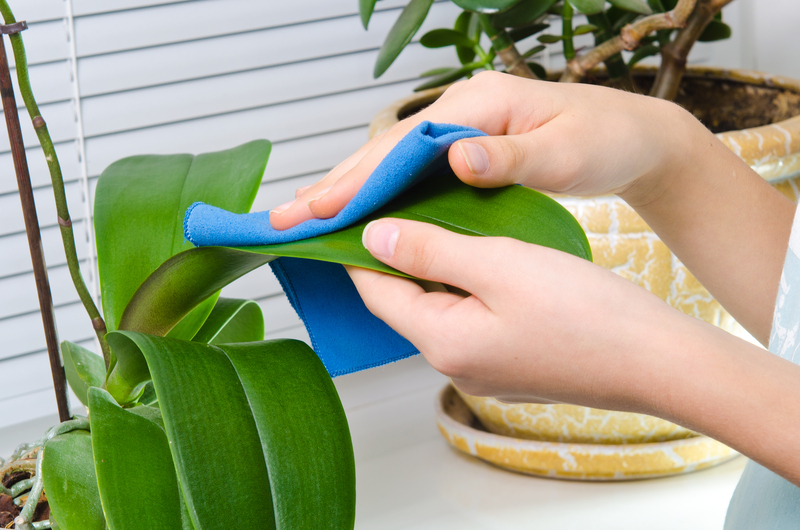Simple Techniques for Mould-Free Window Sills
Posted on 16/09/2025
Simple Techniques for Mould-Free Window Sills
Are you battling with unsightly and unhealthy mould on your window sills? Mould not only looks unattractive but can also cause damage to your home and impact your family's health. Keeping your window sills mould-free is essential for maintaining a clean, safe, and inviting environment. In this comprehensive guide, we'll explore easy and effective methods to prevent and remove mould, keeping your window sills fresh, clean, and free from recurring issues.

Why Do Window Sills Get Mouldy?
Mould, also spelled mold, is a type of fungus that thrives in damp, humid, and poorly ventilated conditions. Window sills are particularly vulnerable due to condensation, leaks, and insufficient airflow. Understanding the root causes is the first step in ensuring mould-free window sills in your home.
Main Factors Contributing to Mould on Window Sills:
- Condensation: Water droplets forming on cold window panes and running down onto sills.
- Poor Ventilation: Trapped moisture due to lack of air flow.
- Leaking Windows: Faulty seals or frames letting in rain and moisture.
- Humidity: High moisture levels indoors, often from cooking, showers, or drying clothes.
By addressing these factors, you can dramatically reduce the likelihood of mould developing on your window sills.
Understanding the Risks: Why You Need Mould-Free Window Sills
Black mould (Stachybotrys chartarum) is particularly common on window sills and is known for producing allergens and irritants. Exposure can lead to health problems, including:
- Allergic reactions
- Respiratory issues
- Exacerbation of asthma and other lung problems
It's not just about appearance. Maintaining clean, mould-free window sills is vital for your wellbeing.
Preparedness: What You Need to Prevent and Clean Mould on Window Sills
Before tackling the mould or preventing it in the first place, prepare with the right tools and supplies:
- Protective gloves and masks
- Soft brush or old toothbrush
- Microfiber cloths
- Spray bottle
- Mild detergent, white vinegar, or baking soda
- Optional: Specialist mould remover for stubborn growth
With the right items at hand, you'll be able to confidently tackle both cleaning and prevention for permanently mould-free window sills.
Step-by-Step: How to Remove Mould from Window Sills Effectively
-
Isolate the Area
Open a window or ensure good ventilation. Wearing a mask prevents inhaling spores. -
Prepare Your Cleaning Solution
Mix equal parts white vinegar and water, or use a baking soda paste. For tougher jobs, use a small amount of household bleach (diluted appropriately). -
Remove Loose Debris
Use the brush or a damp cloth to gently remove visible mould and dust. -
Clean the Surface
Spray vinegar solution onto the affected area and leave it for 5-10 minutes. Scrub gently with the brush, paying attention to corners and edges. -
Wipe and Dry
Wipe down with a clean microfiber cloth. Ensure the area is thoroughly dry to prevent mould returning. -
Dispose of Cleaning Materials Safely
Put used cloths and gloves in a sealed bag and discard. Wash your hands thoroughly.
Repeat the process for each window sill in need. Consistency and thoroughness are key to achieving and maintaining clean, mould-free window sills.
Preventative Measures for Mould-Free Window Sills
Prevention is always better than cure. Adopt these simple yet powerful habits in your home:
Improve Ventilation
- Open windows regularly, especially after cooking or showering.
- Install and use extractor fans in kitchens and bathrooms.
- Use dehumidifiers in rooms prone to high moisture.
Manage Humidity Levels
- Keep indoor humidity below 60%.
- Avoid drying clothes indoors where possible.
- Wipe condensation from window panes daily during colder months.
Check Window Seals
- Inspect windows regularly for cracks, gaps, or failed seals.
- Repair or reseal as necessary to prevent water ingress.
Routine Cleaning
- Wipe down window sills weekly with vinegar or mild detergent.
- Clean up spills or splashes promptly to prevent lingering moisture.
Integrate these straightforward tips into your regular cleaning schedule for ongoing, long-term mould prevention.
Natural and Chemical Solutions for Mould-Free Window Sills
There are various products and DIY solutions that can be effective for keeping your window sills mould-free:
- Vinegar: A natural antifungal agent that kills most types of household mould.
- Baking Soda: Absorbs moisture and eliminates odours while cleaning surfaces.
- Lemon Juice: Natural acidic properties help break down mould and add a fresh scent.
- Commercial Mould Sprays: Effective for stubborn infestations. Follow instructions and use in well-ventilated areas.
- Hydrogen Peroxide: Kills mould and bacteria but may mildly bleach surfaces - spot test first!
Homemade Mould Remover Recipe
- 1 cup white vinegar
- 1 teaspoon baking soda
- 2 cups water
- 10 drops tea tree oil (optional, for extra mould-fighting power!)
Mix these ingredients in a spray bottle, apply to the window sill, leave for ten minutes, then scrub and wipe clean.
Long-Term Strategies: How to Keep Window Sills Mould-Free All Year Round
For ongoing mould prevention on your window sills, consider these additional measures:
- Upgrade Windows: Double glazing reduces condensation and limits cold spots.
- Insulate Frames: Insulated sills and frames minimize temperature differences.
- Room Layout: Avoid placing large furniture against exterior walls, allowing airflow around windows.
- Monitor Plants: Overwatering houseplants near windows can wet sills - use trays to catch drips.
- Decor Choices: Use mould-resistant paints or sealants on window sills, especially in humid homes.
Combine these upgrades and routines to ensure window sills stay clean and resistant to mould, even during damp weather.
Spotting and Addressing Early Signs of Mould
Regular checks can help you catch and treat mould before it spreads:
- Look for discoloured patches (black, green, or grey) on the window sill or frame.
- Notice any musty or earthy odours - both indicate mould growth!
- Feel for dampness, stickiness, or soft wood (a sign of water damage).
If you spot these signs, act immediately with cleaning and take steps to dry the area quickly. Early action prevents major mould build-up and potential health risks.
How to Safely Clean Mould from Wooden Window Sills
Wooden window sills can be especially susceptible to mould and require a gentle touch:
- Use minimal moisture to avoid swelling or warping the wood.
- A soft brush is ideal for lifting mould from the grain.
- After cleaning, consider applying a wood sealant for extra protection.
Always dry wooden sills thoroughly after cleaning to minimize the chance of mould regrowth.
Common Myths About Window Mould Prevention
- Myth: "Leaving windows open overnight will always prevent mould."
Fact: While ventilation helps, outdoor humidity or rain can sometimes make matters worse. - Myth: "Only dirty homes get window mould."
Fact: Clean homes can still develop mould if moisture levels are high and ventilation is lacking. - Myth: "Bleach is always the best option for mould removal."
Fact: Bleach can sometimes discolor or damage surfaces, and may not be as effective on porous materials like wood.

Recap: Your Checklist for Mould-Free Window Sills
- Inspect and clean window sills weekly for early signs of mould.
- Promote airflow by opening windows and using fans.
- Keep humidity in check and wipe away condensation daily.
- Seal any gaps or leaks around window frames promptly.
- Use natural or chemical mould removers as needed and always dry surfaces well.
Conclusion: Enjoy a Cleaner, Healthier Home with Mould-Free Window Sills
Armed with these simple techniques for mould-free window sills, you can proactively stop mould in its tracks, making your home safer and more comfortable for everyone. Routine cleaning, moisture control, and quick response to leaks are the secrets to maintaining window sills free from mould - with noticeable benefits to your home's appearance and your family's health.
Ready to transform your window sills? Start with a good clean today, then keep mould away with regular maintenance and a few smart habits. Healthy, mould-free window sills are just a few steps away!
Did you find these techniques helpful? Share this article and help others discover the best ways to enjoy clean, fresh window sills all year round!





